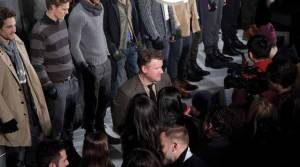
The discovery resonated: Snyder’s collaboration with the 84-year-old heritage brand will be available at Barneys this fall. More importantly, his granddad’s suit reinforced the ascendant Snyder’s philosophies concerning the American man’s style. “Menswear,” he said in a phone interview, “is an evolution, not a revolution.”
Snyder’s own progression has been tougher to predict. Growing up in Ames, Iowa, fashion didn’t even register as a viable career. “Teachers didn’t ask their students, ‘What do you want to be: a doctor, lawyer or clothing designer,’” he says. His first exposure to the field was the CNN program Style with Elsa Klensch, and as a young man he woke up for the show each Saturday it aired.
Real world education came with positions at the Gap, Polo and J. Crew, where for the latter half of the ‘00s he (along with Mickey Drexler, Jenna Lyons and, yes, Michelle Obama) propelled the brand from preppy mallrat afterthought to serious fashion biz contender.
Some would see a J. Crew creative directorship and brand revival as a career culmination. But for Snyder, starting his own line was always the goal. “When I turned 40, I told myself I needed to do this now, or I’ll never do it,” he says. He resigned J. Crew in September 2008.
Two days after Snyder gave notice, Lehman Broths declared bankruptcy. “I was scared shitless,” he says. He’d agreed to remain with J. Crew through January 2009, but colleagues asked him if he was still sure he wanted to strike out on this own, and made it clear he was welcome to stay. Snyder barely flinched, and left J. Crew as planned.
But as the financial markets went into freefall, concessions were made, and confidence dented. A standalone store didn’t materialize. “I immediately realized no bank was going to lend me that kind of money,” he says. “I remember getting my own studio and not being very optimistic.”
Snyder’s Midwestern pragmatism kicked in and the thought of relatively frugal simplicity compared to initial projections for his eponymous line became something of a boon for the company. “I had to get crafty,” Snyder says. He also embraced his notion that men’s fashion should project “casual elegance” while “pairing utility with luxury,” that menswear “is an investment.”
Any early bumps quickly gave way to a smooth road, and Snyder has had a banner 2012. He racked up nominations for GQ’s Best New Menswear Designer title and the Council of Fashion Designers of America’s Swarovski Award for Menswear. GQ creative director Jim Moore proclaimed that, “Todd Snyder [had] arrived.” The magazine described Snyder’s target client as “the guy who wears a jacket and tie because he wants to, not because he has to.” The CFDA nod “was that ‘oh my God moment,” Snyder says. “I didn’t really know if the line was going to work until this year.”
Whichever future plaudits come Snyder’s way are unlikely to tarnish his respect for, and delicate tweaking of, the past. (Snyder, who considers wearing jeans to a wedding “the biggest insult ever,” is big on respect.) “You look at the old photos of Steve McQueen and Paul Newman and there’s nothing really new out there,” he says. “There are nuances, but it’s rooted in how men have always dressed. With men, even the trends last five or ten years” As a young man Snyder never thought his dad and granddad were “with it,” but their style continues to inform the boom in heritage wear that he instigated at J. Crew.
The enduring principles of men’s fashion coexist and collide with an equally stubborn masculine trait: a reluctance to shop. The typical clothing store stocks 80% womenswear and 20% men’s. To attract the guys “you need a certain appeal that isn’t highly trend-driven,” Snyder says. An inclusive rather than insular shopping experience can also overcome a macho aversion to retail, legitimate or feigned. “Men have to want to hang out where they shop,” Snyder says. “It’s a fine line. The salesperson has to be there, but also not there. You have to ease men into it.”

For now, Snyder doesn’t have a brick and mortar outpost to sell his line, but he did collaborate on a pop-up this year with downtown tastemaker Odin. The in-store showcase was supposed to last a month, but remained through the summer. A more permanent pairing is under consideration. “To bring tailoring there was a neat juxtaposition,” Snyder says of working with the rakish retailer. “I think we injected my grandfather’s closet into Odin’s younger clientele. “
In another matchup, Snyder reunited with the Gap to curate a project with the online T-shirt shop Threadless. Nearly 200,000 artists submitted shirt designs, and two million voters determined the winners. At the celebratory event, a young girl approached Snyder. She was shaking, and tears streamed down her face. Concerned, Snyder asked what was wrong. “My shirt is in the Gap store,” she said. “To see her reaction, how proud she was,” Snyder says. “I just thought, ‘That’s why I do this.’”
Snyder hasn’t had much time during his triumphant year to think about the next twelve months. He’ll “continue to push the envelope” and hints at more interesting collaborations that he can’t talk about at the time of our interview. There may be a store by next fall. But expanding the line’s digital retail presence may be the most tantalizing goal. “That’s really how men are starting to shop more and more,” he says. “They’re comfortable with it…in part because their wives do a lot of the online purchasing.”
Kids from the fashion hinterlands also benefit from the democratizing force of the internet and social media. “It’s all so accessible now,” Snyder says. “It’s important to be available to everyone. There’s a whole movement where 20-year-old kids are wearing tailored clothes and Southwick suits. Even in Iowa.”
Like Haute Living New York? Join our Facebook page or follow us on Twitter @HauteLivingNY. Want Haute Living New York delivered to your inbox once a week? Sign up for our newsletter.






















